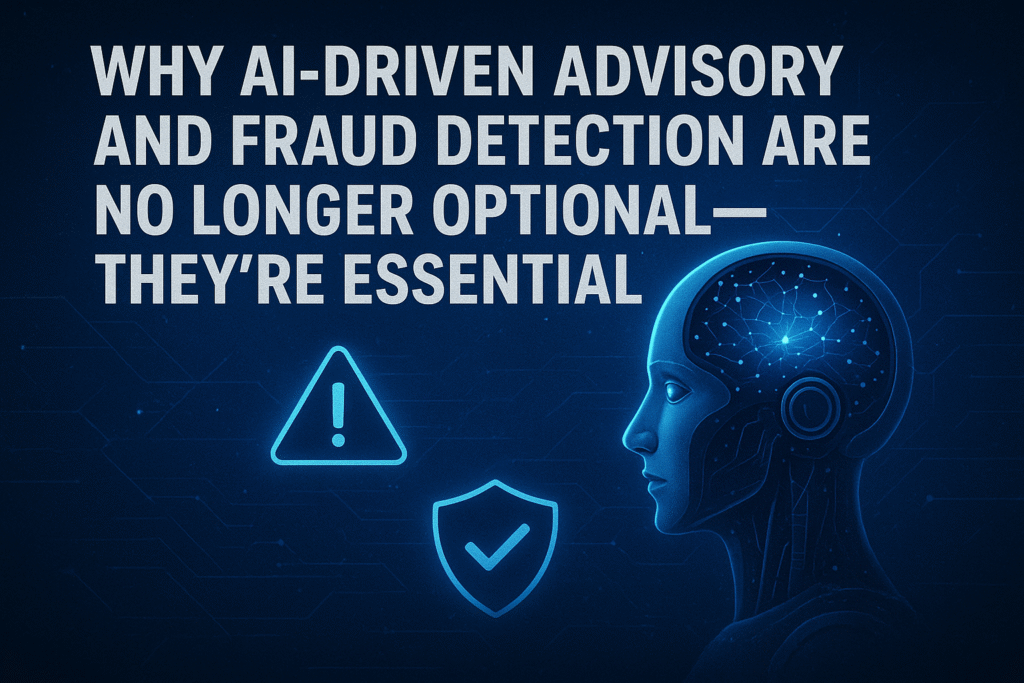The financial landscape has shifted. Discover why AI-Driven Advisory for growth and AI Fraud Detection for security are no longer luxury differentiators but essential, non-negotiable pillars for any modern business’s survival and success.
The New Digital Divide – AI Haves and Have-Nots
A silent, seismic shift is redefining the competitive landscape across every industry. It’s not just about digital transformation anymore; it’s about intelligent transformation. On one side are the leaders: financial institutions that stop fraud before it happens, wealth managers who offer hyper-personalized advice at scale, and e-commerce platforms that seem to know what their customers want before they do. On the other side are the laggards, relying on outdated rules, manual reviews, and gut feelings, watching their margins erode and their defenses crumble.
The chasm between these two groups is powered by one critical differentiator: Artificial Intelligence (AI). Specifically, the dual engines of modern business—AI-Driven Advisory for offensive growth and AI Fraud Detection for defensive security. For years, these technologies were considered “nice-to-have” innovations for the largest corporations. Today, that paradigm has flipped.
This article will demonstrate conclusively that AI-Driven Advisory and AI Fraud Detection have transcended their status as competitive advantages. They have become absolute essentials—the new table stakes for operational integrity, customer trust, and sustainable profitability in a perilous and hyper-competitive digital world. The question is no longer if you can afford to implement them, but if you can afford not to.
The Shield – AI Fraud Detection as a Non-Negotiable Defense
The first and most urgent application of AI is in building an intelligent, impenetrable defense system.
1.1. The Failure of Traditional Rules-Based Systems
For decades, fraud detection relied on static, rules-based engines.
- Rule: “Flag transactions over $1,000.”
- Rule: “Flag logins from a new device.”
- Problem: These rules are brittle, dumb, and easily exploited. They create a catastrophic lose-lose scenario:
- False Positives: They flag legitimate customer activity, leading to declined transactions, frustrated customers, and lost revenue. A study by the Aite Group estimates that false positives cost merchants $443 billion in 2021 alone.
- False Negatives: Sophisticated fraudsters easily learn the rules and structure their attacks to fly just under the radar, leading to successful breaches.
This outdated model is like having a security guard who only knows how to stop people wearing a specific color hat. It’s ineffective and infuriating for everyone involved.
1.2. How AI and Machine Learning Revolutionize Security
AI Fraud Detection replaces simplistic rules with dynamic, intelligent models that learn and adapt in real-time.
- Behavioral Biometrics & Anomaly Detection: AI doesn’t just look at what you’re doing, but how you’re doing it. It analyzes thousands of data points to establish a unique “behavioral fingerprint” for each user:
- Typing rhythm and speed
- Mouse movement patterns
- Common login times and locations
- Device usage patterns
When a transaction occurs, the AI compares it against this established baseline. A tiny deviation—a transfer initiated just milliseconds faster than usual, from a location the user rarely accesses—can trigger an alert, even if the transaction amount is small and the password is correct.
- Network Analysis and Pattern Recognition: AI can see connections invisible to the human eye. It maps relationships between entities (users, accounts, IP addresses, devices) to identify complex fraud rings. For example, it might detect that 50 new accounts were all created from the same IP block, used the same device fingerprint, and are all receiving small test payments from a single compromised account. This is a coordinated attack, and AI can shut it down instantly.
- Predictive Power and Real-Time Scoring: Machine learning models are trained on vast historical datasets of both legitimate and fraudulent transactions. They learn the subtle, multi-dimensional patterns that precede fraud. For every incoming transaction, the AI assigns a real-time risk score (e.g., 0.01 = safe, 0.99 = high-risk fraud). This allows for nuanced decisioning: block the 0.99, challenge the 0.70 with 2FA, and instantly approve the 0.01.
1.3. The Tangible Business Case: Beyond Preventing Loss
The value proposition of AI Fraud Detection extends far beyond merely stopping theft.
- Enhanced Customer Trust and Experience: By drastically reducing false positives, you stop insulting your best customers with fraudulent decline messages. Smooth, secure transactions build immense brand loyalty.
- Operational Efficiency: Automating fraud review frees up valuable human analysts from sifting through thousands of false alerts. They can focus on investigating only the most complex, high-risk cases that truly require human intuition.
- Regulatory Compliance: In an era of stringent data protection laws (GDPR, CCPA) and financial regulations (KYC, AML), AI provides an auditable, data-driven framework for proving due diligence and protecting customer data.
- Enabling Innovation: Robust AI Fraud Detection is the safety net that allows businesses to launch new, potentially riskier products like instant P2P payments, “buy now, pay later” (BNPL) options, and seamless digital onboarding without fear.
The Conclusion is Inescapable: In a world of organized cybercrime and sophisticated attacks, relying on traditional fraud detection is akin to leaving your vault unlocked. AI Fraud Detection is no longer a luxury; it is the essential, foundational layer of digital trust.
The Sword – AI-Driven Advisory as the Engine of Growth
If AI is the shield, then AI-Driven Advisory is the sword—an intelligent, proactive tool for driving revenue, deepening customer relationships, and creating unparalleled value.
2.1. The Limitation of Human-Led, Generic Advice
The traditional model of advisory—whether in finance, e-commerce, or healthcare—has inherent scalability and personalization problems.
- Wealth Management: A human financial advisor can only effectively manage a limited number of client relationships. Their advice is often based on quarterly reviews and can be influenced by human bias.
- E-Commerce: Generic ” customers who bought this also bought that” recommendations are a primitive form of personalization that often misses the mark.
- B2B SaaS: Customer success managers are overwhelmed and can only react to problems, not predict and prevent them.
This model is reactive, inefficient, and fails to unlock the full potential of the customer relationship.
2.2. The Power of Hyper-Personalization at Scale
AI-Driven Advisory flips the script from reactive to predictive and prescriptive.
- Wealth Management (Robo-Advisors 2.0): Modern platforms like Betterment and Wealthfront use AI to go far beyond basic portfolio allocation. They offer:
- Tax-Loss Harvesting: AI algorithms scan thousands of transactions daily to automatically sell securities at a loss to offset taxes on gains and income, a tactic previously only available to the ultra-wealthy.
- Portfolio Optimization: AI continuously rebalances portfolios based on real-time market conditions, risk tolerance shifts, and personal life events (e.g., a user starts saving for a home).
- Personalized Insights: Instead of a generic newsletter, the AI analyzes a user’s spending, income, and goals to provide tailored advice like: “Based on your increased cash flow this month, increasing your 401(k) contribution by 2% would put you on track to retire 18 months earlier.”
- E-Commerce and Marketing: AI is the engine behind the personalized experiences we now expect.
- Predictive Product Recommendations: Netflix, Amazon, and Spotify use sophisticated AI models to predict what you want to watch, buy, or listen to next with stunning accuracy, dramatically increasing average order value and customer engagement.
- Dynamic Pricing: AI algorithms adjust prices in real-time based on demand, competitor pricing, inventory levels, and a user’s willingness to pay.
- Churn Prediction: AI can identify customers who are at high risk of leaving (e.g., reduced login frequency, support ticket sentiment) and trigger proactive retention campaigns with special offers or personalized check-ins.
- B2B and SaaS:AI-Driven Advisory transforms customer success from a cost center into a value center.
- Proactive Support: AI analyzes product usage data to identify customers who are struggling with a feature and automatically serves them a tutorial video or knowledge base article before they ever need to file a support ticket.
- Success Forecasting: The AI can advise the customer: “Companies that use features X, Y, and Z together see a 30% higher ROI. You’re only using X and Y. Would you like a demo of Z?”
2.3. The Tangible Business Case: From Cost Center to Profit Center
The ROI on AI-Driven Advisory is measured in growth, loyalty, and efficiency.
- Increased Revenue and Customer Lifetime Value (CLV): Hyper-personalization leads to higher conversion rates, larger average order values, and more frequent purchases. Predictive advisory keeps customers engaged and loyal for longer.
- Reduced Churn and Enhanced Loyalty: By proactively solving problems and delivering unexpected value, you build “stickiness” and turn customers into advocates.
- Scalable Expertise: You can offer a level of personalized, 24/7 advisory service that would be impossible to deliver with a human-only team, democratizing expertise for your entire customer base.
The Conclusion is Inescapable: In a battle for customer attention and wallet share, generic, reactive service is a death sentence. AI-Driven Advisory is the essential tool for creating the personalized, predictive experiences that modern consumers demand.
Part 3: The Convergence – Where Advisory and Defense Become One
The most powerful realization is that these two pillars are not separate. They are converging into a single, intelligent system that simultaneously protects and empowers.
A prime example is in banking and fintech:
- The AI Fraud Detection system notices a user attempting a large transfer to a new recipient.
- Instead of just blocking it (causing friction) or allowing it (creating risk), the system triggers an AI-Driven Advisory flow.
- The customer receives an alert: “We noticed an unusual large transfer. For your security, we’ve held this. Data shows that 35% of similar payments to this merchant were reported as fraudulent. Did you intend to make this payment? Would you like to schedule a call with a fraud specialist?”
- This seamless integration turns a potential security incident into a moment of trusted, value-added consultation.
This is Banking 2.0—a system that is intelligent, contextual, and built around the dual mandate of zero-trust security and ultimate customer empowerment.
Part 4: Implementation – Making the Essential a Reality
Adopting these technologies is no longer the domain of only tech giants.
- The API Revolution: You don’t need to build these systems from scratch. A thriving ecosystem of third-party providers offers powerful AI Fraud Detection (e.g., Sift, Riskified) and AI-Driven Advisory tools as easy-to-integrate APIs.
- Start with a Pilot: Focus on your highest-value or highest-risk use case first. For fraud, this might be new account registrations or payment processing. For advisory, it could be your premium customer segment.
- Culture of Data: AI runs on data. Ensure you are collecting clean, structured, and ethical data to feed your models.
- The Human-in-the-Loop Model: AI is not about replacing humans. It’s about augmentation. The ideal model uses AI to handle the repetitive, high-volume tasks and surfaces critical, complex decisions to human experts for final judgment.
Conclusion: The Choice is Binary
The evidence is overwhelming. The technological shift has already happened. The cybercriminals are using AI, and your most innovative competitors are using AI.
The business landscape has been permanently altered. There is no longer a middle ground. You are either building a modern, intelligent organization equipped with AI-Driven Advisory and AI Fraud Detection, or you are willingly operating with a critical strategic vulnerability.
This is not a future-state prediction. This is the present-day reality. The question of adoption has moved from the boardroom wish list to the operational necessity list. The cost of inaction—in lost revenue, eroded trust, and failed customer relationships—now far exceeds the investment required. The essential future is here. It’s time to build it.


